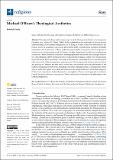Files in this item
Michael O'Brien's Theological Aesthetics
Item metadata
| dc.contributor.author | Lamb, Rebekah | |
| dc.date.accessioned | 2021-06-18T15:30:12Z | |
| dc.date.available | 2021-06-18T15:30:12Z | |
| dc.date.issued | 2021-06-18 | |
| dc.identifier | 274709813 | |
| dc.identifier | 81adc4bf-0760-4988-b18a-e32971bc957b | |
| dc.identifier | 85108882907 | |
| dc.identifier | 000666020600001 | |
| dc.identifier.citation | Lamb , R 2021 , ' Michael O'Brien's Theological Aesthetics ' , Religions , vol. 12 , no. 6 , 451 . https://doi.org/10.3390/rel12060451 | en |
| dc.identifier.issn | 2077-1444 | |
| dc.identifier.other | ORCID: /0000-0003-2405-4452/work/95772816 | |
| dc.identifier.uri | https://hdl.handle.net/10023/23388 | |
| dc.description.abstract | This essay introduces and examines aspects of the theological aesthetics of contemporary Canadian artist, Michael D. O’Brien (1948–). It also considers how his philosophy of the arts informs understandings of the Catholic imagination. In so doing, it focuses on his view that prayer is the primary source of imaginative expression, allowing the artist to operate from a position of humble receptivity to the transcendent. O’Brien studies is a nascent field, owing much of its development in recent years to the pioneering work of Clemens Cavallin. Apart from Cavallin, few scholars have focused on O’Brien’s extensive collection of paintings (principally because the first catalogue of his art was only published in 2019). Instead, they have worked on his prodigious output of novels and essays. In prioritising O’Brien’s paintings, this study will assess the relationship between his theological reflections on the Catholic imagination and art practice. By focusing on the interface between theory and practice in O’Brien’s art, this article shows that conversations about the philosophy of the Catholic imagination benefit from attending to the inner standing points of contemporary artists who see in the arts a place where faith and praxis meet. In certain instances, I will include images of O’Brien’s devotional art to further illustrate his contemplative, Christ-centred approach to aesthetics. Overall, this study offers new directions in O’Brien studies and scholarship on the philosophy of the Catholic imagination. | |
| dc.format.extent | 16 | |
| dc.format.extent | 2017851 | |
| dc.language.iso | eng | |
| dc.relation.ispartof | Religions | en |
| dc.subject | Michael O'Brien | en |
| dc.subject | The Catholic imagination | en |
| dc.subject | Theological aesthetics | en |
| dc.subject | Visual arts | en |
| dc.subject | Prayer | en |
| dc.subject | Roman Catholic tradition | en |
| dc.subject | Devotional art | en |
| dc.subject | Christian aesthetics | en |
| dc.subject | Roman Catholicism | en |
| dc.subject | Canadian art | en |
| dc.subject | BR Christianity | en |
| dc.subject | T-DAS | en |
| dc.subject.lcc | BR | en |
| dc.title | Michael O'Brien's Theological Aesthetics | en |
| dc.type | Journal article | en |
| dc.contributor.institution | University of St Andrews. School of Divinity | en |
| dc.identifier.doi | https://doi.org/10.3390/rel12060451 | |
| dc.description.status | Peer reviewed | en |
This item appears in the following Collection(s)
Items in the St Andrews Research Repository are protected by copyright, with all rights reserved, unless otherwise indicated.

